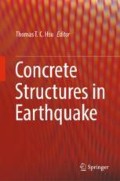Abstract
Two real scale five-storey reinforced concrete frame buildings were tested in BRI in order to evaluate damage of reinforced concrete structural members such as beams, columns, and walls for strength-based design buildings. A series of experimental works show that secondary RC walls could have improved seismic performance for damage reduction by changing configuration and rebar arrangement.
Access this chapter
Tax calculation will be finalised at checkout
Purchases are for personal use only
References
Architectural Institute of Japan. (2004). Guidelines for Performance Evaluation of Earthquake Resistant Reinforced Concrete Buildings (Draft).
CEB-FIP. (1978). Model code for concrete structures, 15.2.3 Limit states of cracking, pp. 156–160.
Ciampi, V. et al. (1982). Analytical model for concrete anchorages of reinforcing bars under generalized excitations. Berkeley: University of California. (Report No. UCB/EERC-82/23).
Fukuyama, H. (2015). Static loading test on a full scale five story reinforced concrete building utilizing wing walls for damage reduction. C-2, pp. 361–362. Summaries of technical papers of Annual Meeting Architectural Institute of Japan.
ITOCHU Techno Solutions Corporation. (2016). Science and Engineering Systems Division: Final user’s manual.
Izumo, J., Shima, H., & Okamura, H. (1987). Analytical model for reinforced concrete panel elements subjected to in-plane forces. Concrete Research and Technology, 25(9), 107–120.
JBDPA (The Japan Building Disaster Prevention Association). (2015). Seismic Evaluation and Retrofit.
Kabeyasawa, T., Mukai, T., & Fukuyama, H., et al. (2016). A full scale static loading test on five story reinforced concrete building utilizing columns with wing walls. Journal of Structural and Construction Engineering, Transactions of AIJ, 81(720), 313–322.
Kabeyasawa, T., Mukai, T., Fukuyama, H., Suwada, H., & Kato, H. (2017). Full-scale static loading test on a five story reinforced concrete building. In 16th World Conference on Earthquake Engineering, January 9–13, Paper No. 1242. Santiago: Chile.
Kitamura, F. (2017). Damage evaluation of five-story building by nonlinear finite element analysis. Master thesis of Tokyo Institute of Technology.
Kono, S., Kitamura, F., Yuniarsyia, E., Watanabe, H., Mukai, T., & Mukai, D. (2017) Efforts to develop resilient reinforced concrete building structures in Japan. In Proceedings of the Fourth Conference on Smart Monitoring, Assessment and Rehabilitation of Civil Structures, September 2017, pp. 13–15, Paper ID #KN30. Zurich, Switzerland.
Maeda, M., Nakano, Y., & Lee, K. (2004). Post-Earthquake Damage evaluation for R/C buildings based on residual seismic capacity. In Proceedings of 13 World Conference on Earthquake Engineering. Paper ID 1179.
MLIT (Ministry of Land, Infrastructure, Transportation and Tourism). (2015). The 2015 guidelines of structural design technology of buildings.
Naganuma, K. (1995). Stress–strain relationship for concrete under triaxial compression. Journal of Structural and Construction Engineering, Transactions of AIJ, 474, 163–170.
Sato, Y., & Naganuma, K. (2011). Crack width analysis using smeared-crack-based fem: Part 8. C-2, pp. 241–242. Summaries of tech. papers of Annual Meeting Architectural Institute of Japan.
Acknowledgements
This study was carried out by a joint study of National Technology Development Project of MLIT “Development of function sustaining technologies for buildings used as Disaster Prevention Bases” (2013~2016) and Priority Research Program of BRI Development on Seismic Design Method for Building with Post Earthquake Functional Use” (2013~2015). The efforts in measuring concrete cracking by Tokyo Institute of Technology, Tokyo University of Science and Tohoku University and seven participating companies are gratefully acknowledged. A part of this study was conducted as Scientific Research A (PI: Susumu Kono) of JSPS Grant-in-Aid program. Some financial support was also granted by the World Research Hub Initiative of the Institute of Innovative Research and the Collaborative Research Project of Materials and Structures Laboratory at Tokyo Institute of Technology.
Author information
Authors and Affiliations
Corresponding author
Editor information
Editors and Affiliations
Rights and permissions
Copyright information
© 2019 Springer Nature Singapore Pte Ltd.
About this paper
Cite this paper
Kono, S. et al. (2019). Research on Resilient Reinforced Concrete Building Structural System. In: Hsu, T. (eds) Concrete Structures in Earthquake. Springer, Singapore. https://doi.org/10.1007/978-981-13-3278-4_6
Download citation
DOI: https://doi.org/10.1007/978-981-13-3278-4_6
Published:
Publisher Name: Springer, Singapore
Print ISBN: 978-981-13-3277-7
Online ISBN: 978-981-13-3278-4
eBook Packages: EngineeringEngineering (R0)

